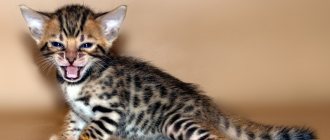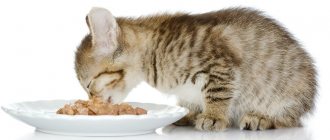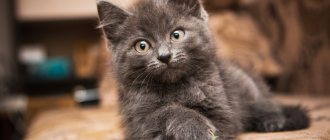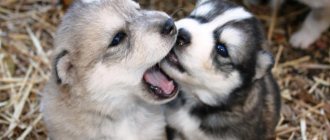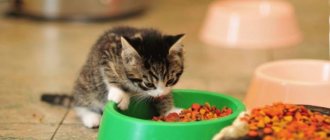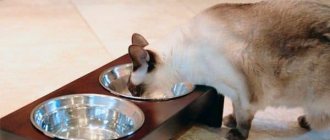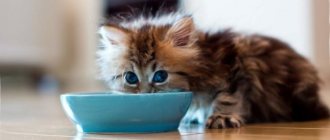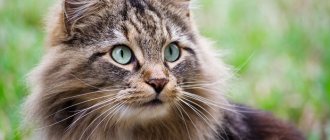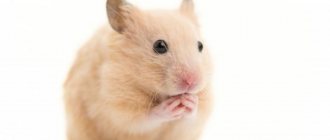Bengal kittens have become popular. People from all over the world are increasingly buying them, and the new breed is conquering more and more people. The owners immediately have a logical question - what to feed their Bengal kittens.
The breed appeared in the last century, it combines the habits of a pet and the body of a predator, with characteristic spots.
What to feed Bengal kittens
Even a person who does not often encounter animals will notice that Bengal cats are different from their four-legged counterparts. Given their wild nature, kittens require special care and want a lot of attention. We will separately consider what to feed such animals.
Bengal kittens: what to feed, care features and recommendations
Bengal kittens need to be educated from an early age, let them get used to hands and people, otherwise they can grow up wild and get scared of people.
Kittens of this breed love heights and climb any heights. It so happens that many representatives of the cat family in the wild are forced to conquer heights and not be afraid of them.
The Bengal cat loves to climb high places
Be sure to build or buy your four-legged friend a hill that he can climb without difficulty and with interest. Otherwise, the pet will begin to conquer all the heights that are at home: cabinets, shelves, refrigerator or even windows.
On a note! You need to pay special attention to windows. Like most animals, Bengals will happily and without fear approach the windows and observe the situation outside the apartment. If you live above the first floor, then be sure to make sure that the kitten cannot fall out of the window, keep an eye on the animal and do not let it near open windows.
Otherwise, Bengal cats are very similar to ordinary cats and do not require any special care.
Bengal cat
Bengal kitten diet
You cannot suddenly change the food that the kitten is accustomed to. Transfer him to another food gradually, over a week.
Give babies food special for kittens up to 1 year old.
Once you decide what to feed your Bengal kitten, keep an eye on its weight. Often Bengals begin to get very fat, in this case change the food.
The nutritional characteristics of the Bengal kitten include a very sensitive intestine and frequent stomach upsets. Therefore, the better quality food a kitten receives, the better its stool will be.
Among natural foods, such kittens are very fond of lean beef and beef heart. It is better to give boiled beef. If the kitten hasn't finished eating, put the meat in the refrigerator.
So, when a Bengal kitten appears in your home, pay close attention to its nutrition: select the optimal food and make sure that the pet receives all the necessary vitamins and microelements. Also diversify the kitten's diet with various foods - alternate turkey, beef, chicken, rabbit, and alternate other foods.
What to feed a Bengal cat
From their wild counterparts, Bengal cats have inherited not only a playful character and an interesting color. The fact is that wild felines do not need a long esophagus. They feed exclusively on meat, so in the process of evolution they received a short intestine, which was inherited by this wonderful breed.
Because of this feature, owners often feed their pets something completely different from what they need. If you feed your four-legged friend for so long, he may develop quite serious digestive problems. This will have an extremely negative impact on his health and life expectancy.
Bengal cat eats dry food
It is important to understand what a cat can eat and what foods are best kept away from him. Let's figure it out.
Ready-made food or natural food
This is the first question that arises for the owners of any cat. Here you need to think about the fact that Bengal cats, and most other pets, get stomach problems when switching from food to natural food.
The main diet of the wild relatives of this breed is meat. A domestic cat needs a balanced diet, but it is best to use ready-made food. The finished products already contain all the substances a Bengal cat needs. With them, the animal will not have digestive problems, and he will be able to live a full, happy life.
Bengal begs for minced meat
But Bengal cats, who are fastidious in their diet, can and should be fed only with fairly expensive food that belongs to the premium class. Not everyone can afford to buy expensive, high-quality cat food, and cheap food from the supermarket can only harm the cat.
If possible, it is better to feed your Bengal ready-made, balanced koma. Let's look at which foods are best suited.
The best ready-made food for Bengal cats
Here we will try to provide food for Bengals that is approved by experts in the field of cat breeding or veterinarians.
Table 1. Best dry food for Bengal cats.
| Name | Description |
| Orijen Six Fish Cat | This is a holistic fish food that contains everything a cat needs for normal life. The food consists of 42% protein, which is taken from salmon, poultry and other fish, and 20% fat. These are excellent indicators for cat food. But the fat in this version comes from canola oil, which is a fairly cheap and low-quality source of fat. The food contains many substances, including medicinal plants. |
| WildCat Etosha | This is expensive German food. This food contains 46% protein and 23% fat. Most of the protein comes from chicken and chicken meal. In addition, the food contains no grains, and there are special prebiotics that ensure the absence of digestive problems even in fastidious Bengal cats. |
| Royal Canin Bengal Adult | This product can only be given to animals that are over one year old. In addition, it contains corn, which the cat could theoretically be allergic to. Therefore, you need to carefully monitor your cat’s reaction to this food. If he doesn’t like it, then it’s better not to risk it and buy another one. Contains important vitamins that a cat needs for normal functioning. This French food is also not very expensive, and its protein content is 40% and fat - 18%. |
Natural food for Bengal kittens
Cats of this breed can be fed regular food. It is important to choose the right food for your pet.
A cat's diet should consist of approximately 70% raw meat. To avoid infecting your cat with parasites, you need to keep the meat in the freezer for a long time - up to 4 days if it is a regular freezer.
Bengal cat eats meat
After removing from the freezer, the meat should be doused with boiling water and cut into medium-sized pieces. For young and healthy cats, there is no need to grind the meat. Bengal cats need stress on their teeth and jaws.
Your cat's diet can include:
- lung;
- kidneys;
- boneless fish meat;
- cottage cheese with a low fat content. Less than 5 percent is preferable;
Bengal cat near a bowl
- vegetables, both raw and cooked. Vegetables in a cat's diet should be about 15% of the total amount of food;
- When kittens lose teeth, they can be given bird necks. They need to be cleaned of all excess and cut;
- cereals, such as rice or buckwheat. Cereals account for 5% of the Bengali diet;
- eggs, quail eggs are perfect. In the wild, representatives of the cat family often destroy bird nests and feast on eggs.
Some cat breeds should not be given milk. Bengal cats are not like that. Most of them calmly drink cow's milk. But, although rare, an animal may be allergic to it. Therefore, you should give milk to your Bengal with caution, studying his reaction to the new drink.
Allergy is the sensitivity of an animal's immune system to certain allergens, some of which can even lead to the death of the four-legged animal. The reaction to allergens manifests itself in cats with certain symptoms. You can read more about allergies to food in cats in our separate article.
Diet features
- Meat is the basis of the diet, because Bengals are pronounced predators. Raw lean meat is recommended, at least 70% of the daily serving. With such a diet there is a risk of infection with parasites. Therefore, meat and fish should be stored deep frozen. And before feeding, they must be cut into small pieces (but not minced or shaved) and doused with boiling water. You can diversify your cat's diet with liver: hearts, liver, lungs. The Bengal also needs bones, but not sharp tubular ones: the best option would be bird necks and articular cartilage.
- The predator also needs fish, but not often - 2-3 times a week will be enough. The main thing is that there are no small bones in it. Therefore, river fish are not very suitable for Bengals. You should not often give fish to males - they are prone to developing urolithiasis, and fish can speed up this process.
- Eggs, especially quail eggs, are often a favorite treat for cats, especially the yolk. In this case, you need to focus on the natural type of food: in nature, wild cats do not often manage to destroy the nest to feast on eggs. In a home environment, the feeding schedule should be the same: eggs can be given no more than once a week.
Or choose ready-made food?
Industrial feed.
It should be remembered that the Bengal's intestines are quite sensitive. Therefore, the type of nutrition of a Bengal cat must be determined in childhood, in the first year of life. It is undesirable to switch an adult animal from natural food to industrial food. And, if such a need has arisen, such a transition will require a lot of time. When choosing food, you should pay attention to its quality and composition. We recommend premium and super-premium products that contain the maximum amount of animal proteins. When choosing canned food, you should definitely pay attention to the fat content: Bengal cats can have no more than 20% fat.
Liquid consumed - how much and what
- Cow's milk, unlike most domestic cats, is not contraindicated for Bengals. Moreover, they love him. But it is worth remembering that as a result of selection, the Bengal breed also received domestic genes, so milk intolerance is quite possible. To avoid problems, you just need to monitor the condition of the kitten at the time of feeding milk: if he likes such a treat and he assimilates it without problems, then you can occasionally pamper your pet with warm milk. If you have any doubts, it’s better not to take risks. But Bengals are not very friendly with fermented milk products. If you accustom them to this product, then you need to monitor the composition - no more than 3% fat.
cat needs fluid - There must be fresh water in the bowl. But this is not enough: Bengals love to drink running water. Therefore, sometimes you need to leave the tap open or buy a fountain that will constantly work.
Thus, a single meal should consist of 70% meat, 15% vegetables and no more than 5% cereals. The remaining 10% can be liver, egg or fish. One serving should be from 200 g to 400 g. An adult cat can be fed 2-3 times a day. Even predators find vitamins in the natural environment. It is more difficult for your pet Bengal to find the right herb. Therefore, vegetables should still be present in the diet, but not more than 15% of the daily food volume. But many experts do not recommend porridge at all: it is poorly digested by predators and provides a lot of calories.
Feeding tips
It is recommended to prepare the mixture for feeding your Bengal cat in advance: cut it into small pieces, boil the cereals, mix and freeze. Before feeding, the portion is defrosted to room temperature and doused with boiling water.
Bengal menu
You can add fish oil to each serving at the rate of 5 ml per kilogram of food.
For cats, seaweed will be a useful supplement - no more than ten grams per serving just a couple of times a week. True, tailed predators do not really like this additive. But if you convince the cat, the benefits will be undoubted.
What not to feed Bengal cats
There is also a list of products that you should absolutely not give to your four-legged friends. It included:
- any fatty meat, duck, lamb;
- pork, because not all parasites in it are killed by freezing;
- any sweets, including chocolate;
Sweets are not allowed for cats
- any bones that are often given to cats and dogs from the table;
- fish without bones. Bones can injure the insides of the animal.
Most foods that people love to eat are dangerous for cats. They cause indigestion, weakness, urolithiasis and other troubles. You can learn more about what you should not feed cats in our separate article.
Nutrition for an adult Bengali
The best way to feed a cat, dry food or natural food, depends on each individual owner. Ready-made food is considered balanced and contains the entire range of nutrients a pet needs. This diet has many advantages, but there are also disadvantages.
The health of a cat depends on what food it is fed, since some dry or wet food contains components that are undesirable for a Bengal to consume. These are unnatural flavors and flavoring additives on which the cat becomes dependent, soy pomace, and other low-quality components. Every cheap cat food has these qualities.
More expensive foods are made from a variety of high-quality products; they include vitamins and nutritional components. These products have a higher cost. There are 4 main classes of feed, which are qualitatively different from each other. To figure out which food is better, let’s rank the most popular companies producing industrial diets:
- economy class – “Meow”, “Kitekat”, “Whiskas”;
- premium class for cats - “Royal Canin Bengal Adult”, “Mother Babycat Royal Canin”, “Hills”, “Bozita”;
- super-premium class - “1st Choice”, “Arden Grange”, “Cimiao”, “Chicopee adult cat”;
- holistic – “Acana”, “Orijen”, “Chicken Soup”.
The best product for Bengal cats will be of the holistic class - these foods are completely suitable for animals of a particular breed. You can use more common feeds that cost less, but the quality of such products will be appropriate. How to feed your pet a dry product is described on the packaging. There you can also find information on how to calculate the daily volume for a specific animal, taking into account its weight and age.
You can feed your Bengal cat natural food just as effectively and completely. The adult diet of an animal is based on the proportion: one part of food of animal origin to one part of plant origin. This is boiled meat, for example, beef or chicken, boiled fish, liver, hearts, kidneys, lungs, stomachs, raw and boiled vegetables, for example, carrots or beets, cereals (wheat, oatmeal).
A spayed cat or neutered Bengal cat should be fed low-calorie premium, super-premium or holistic food. It is imperative to ensure constant access to fresh water. As for natural foods, it is better to stick to low-fat and protein foods, for example, poultry and poultry-based cereals.
Whatever you feed your Bengal cat, you need to give the animal additional vitamins. Bengals need specialized complexes with a high content of calcium and magnesium. The main indicator that food (natural or industrial) is suitable for an animal is its activity and well-being.
How many times to feed a Bengal kitten, what should be the portion?
Very young kittens are fed up to 6 times a day, in small portions. As Bengals grow older, the number of meals decreases to 3. At 6 months, kittens need three meals a day.
baby bengal
For an adult cat, the normal portion is 300, 400 grams. This is exactly how much a healthy cat or cat eats at one time.
It is not advisable to feed animals strictly according to their wishes. It is better to accustom your pet to a diet; this can be done from 1.5 months.
Feeding newborns and very young cats
Newborn kittens are almost never sold, because they are very difficult to care for and feed. This burden falls entirely on the kitten's mother. She will do the best job feeding a young Bengal.
The cat feeds very small Bengals
If there is no cat, but the kitten still comes to you, then you will have to watch it especially closely. You need to feed a kitten that is not even a month old with milk. Special mixtures and cat milk substitutes work well. I can recommend “KITTY-MILK” from Beaphar.
KITTY-MILK
The same powder can be used for additional feeding of kittens that feed on mother's milk. Many experts consider this substitute to be one of the best. Feed should be strictly according to the instructions.
Kittens from 1 to 4 days should be given 30 ml. mixtures per day per 100 grams of their weight.
When your pets are 5-13 days old, you can give them 38 ml. mixture per 100 grams of their weight, thereby gradually increasing the dose of nutrients.
What to feed a Bengal kitten who is two months old
Once they reach two months, kittens are fed more than just milk. An excellent option would be to start feeding him what is natural for him in nature - meat. But it needs to be prepared in a certain way, so as not to harm the kitten. At first, it is better to boil the meat, then cut it into very small pieces.
But in nature, no one cooks meat for cats, so you can give raw meat, in which case it will need to be frozen for a long time. At first, it’s better to play it safe and leave it in the refrigerator for several days or weeks. Then a thin layer is removed from the meat using a knife. The resulting shavings are doused with boiling water and given to the kitten.
Bengal at 2 months
Another good option would be porridge with meat, for example, rice. It should be given with plenty of water or milk. The finished product should resemble a thick substance.
